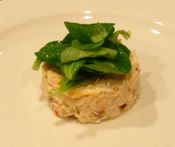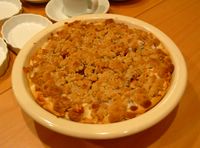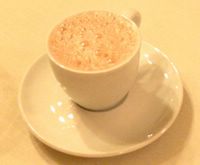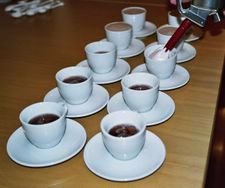This is the seventh in a series of posts directed to a holiday dinner party that I recently held at my home, for which I put together a six-course menu comprised of dishes inspired by the Bay Area's four-star chefs. For more on the dinner, please see these posts: Intro |
Menu Planning, Pt. 1 |
Menu Planning, Pt. 2 |
Course 1 |
Course 2 |
Course 3 | Course 4 |
Course 5 |
Course 6 |
Closing 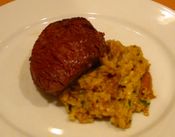
Among the seven four-star chefs, there is one who has done more than any other to broaden my understanding of what can be achieved through cuisine, to demonstrate what it means to pursue excellence with a passion that borders on obsession, and to exert the greatest influence on my own approach to cooking and dining, and that is
Thomas Keller.
Alice Waters, meanwhile, can be fairly credited as being the founder of the entire culinary philosophy under which the other four-star chefs now operate, with cooking seasonally and using fresh, quality ingredients being the fundamental tenets. Indeed, one could argue that if it weren't for Alice Waters, the craft that is today being plied by Keller and the others would look very different. Thus, given the critical importance of Keller and Waters to the Bay Area's fine dining scene, it seemed quite fitting that creations from their respective restaurants would share a plate on my menu as the "main" course.
And yet, the specific selections that made it onto my menu - steak from
The French Laundry, risotto from
Chez Panisse - struck me as ironic on a couple of levels. To begin with, neither dish is particularly difficult or groundbreaking; indeed, one might argue that these items are actually
out of favor in the Bay Area's four-star establishments, with steak in particular being quite rare among the entries found on the typical chef's tasting menu. So, in effect, I had put together a menu on which two of the most important and influential chefs would be contributing two of the least complicated and least novel dishes. Furthermore, because I had previously tried my hand at a number of recipes from Thomas Keller, I had no shortage of interesting and satisfying options from him from which to choose: Cauliflower Panna Cotta, Corn Agnolotti, Salmon Cornets, White Truffle Risotto. Yet, here I was, going with steak from a recipe - entitled
"Yabba Dabba Do" no less - that I had never even tried before. In the end, however, the simplicity of the steak and risotto dishes worked exceedingly well, as it showcased the ability of these talented chefs to achieve outstanding results almost exclusively through the use of high quality ingredients.
I knew that I wanted to purchase my steaks from a purveyor known for high-quality, hormone-free, humanely-raised beef. The two names that immediately came to mind were
Niman Ranch and
Prather Ranch. Niman Ranch, which maintains a stall at the Saturday morning farmers’ market at the Ferry Building, probably has a slight edge in terms of name recognition and representation on four-star restaurant menus, so my initial inclination was to go with them. On the morning of my dinner party, I went to the Ferry Building, walked up to the Niman Ranch stall, examined the two perfectly-marbled and uniformly-shaped filets on display, and proceeded to ask for ten steaks. As one visibly stunned guy started scrambling through large coolers and flipping through inventory sheets to determine how many filets they had on hand, his co-worker told him it was pointless given that they had loaded only four filets in the cooler that morning. Now, I'm not entirely sure why a large and successful outfit like Niman Ranch does not have a permanent storefront inside the Ferry Building, but its "stall and cooler" method resulted in at least one lost sale that morning.
~ ~ ~ ~ ~
There's more...
 I then walked over to Prather Ranch, which does maintain a storefront inside the Ferry Building. Prather's beef is hormone-free and humanely-raised just like Niman Ranch's, but Prather apparently goes one step further and raises its cattle on nothing but organic feed and pure mountain spring water. When I asked for ten filets, the guy behind the counter pulled out a large tray containing over twenty individually-wrapped steaks and invited me to pick whichever ten I wanted. One unusual attribute of these filets was that they did not have the typical filet mignon "shape"; rather, they were somewhat thinner and had varying asymmetrical contours. Because I needed to find steaks of similar thickness to ensure uniform cooking times and of similar shape for presentation purposes, I spent several minutes shuffling through the selections on the tray until I found ten to my liking. When I told the guy helping me that I had never purchased from Prather before, he tossed in a free 1-pound package of their ground beef – proudly explaining how Prather uses only the finest cuts for its ground beef, how each package comes entirely from a single animal, and how Prather employs the highest standards in raising its cattle. I have to say, I was impressed – with the company, with the service, and, ultimately, with the steaks and the ground beef.
I then walked over to Prather Ranch, which does maintain a storefront inside the Ferry Building. Prather's beef is hormone-free and humanely-raised just like Niman Ranch's, but Prather apparently goes one step further and raises its cattle on nothing but organic feed and pure mountain spring water. When I asked for ten filets, the guy behind the counter pulled out a large tray containing over twenty individually-wrapped steaks and invited me to pick whichever ten I wanted. One unusual attribute of these filets was that they did not have the typical filet mignon "shape"; rather, they were somewhat thinner and had varying asymmetrical contours. Because I needed to find steaks of similar thickness to ensure uniform cooking times and of similar shape for presentation purposes, I spent several minutes shuffling through the selections on the tray until I found ten to my liking. When I told the guy helping me that I had never purchased from Prather before, he tossed in a free 1-pound package of their ground beef – proudly explaining how Prather uses only the finest cuts for its ground beef, how each package comes entirely from a single animal, and how Prather employs the highest standards in raising its cattle. I have to say, I was impressed – with the company, with the service, and, ultimately, with the steaks and the ground beef.
I also needed to find some excellent chanterelle mushrooms for my risotto, and where better to look for these than just a few doors down from Prather Ranch at Far West Fungi. The folks from Far West Fungi always have an incredible array of fresh mushrooms on display, and they did not disappoint on the day in question. I picked up a couple of brown paper bags and filled them to the brim with incredibly large, beautiful, golden amber chanterelles. As I stood there waiting to pay, a bag of Prather filets in one hand and a treasure of chanterelles in the other, I once again marveled to myself about what an amazing place the Ferry Building is.
Recipe, Tweaks, Tips and Techniques
The recipes that I used for this course are fairly straightforward. The Thomas Keller recipe with which I started called for rib steak with Bordelaise sauce topped with chanterelles sautéed in butter; the Chez Panisse recipe called for a relatively standard risotto into which a mix of wild mushrooms is incorporated. In order to fuse the two recipes together while also indulging my preference regarding the cut of meat, I resolved to serve pan-seared filet mignon with Bordelaise sauce set atop a bed of chanterelle risotto.
In terms of the order in which to tackle this dish, the Bordelaise sauce should definitely be completed first and well ahead of service. I would also recommend starting and nearly finishing the risotto shortly before guests arrive, leaving only the final stages of the cooking process for completion immediately before service. And while the risotto is finishing up, the steaks can be cooked and prepared for plating.
The recipe set forth below is the one that I used the night of my dinner party. The only "specialized" equipment referenced here are an electronic meat thermometer and a brush for cleaning mushrooms:
| Filet Mignon with Wild Mushroom Risotto |
|---|
Inspired by Thomas Keller, The French Laundry
and Alice Waters, Chez Panisse
|
|
Bordelaise Sauce
- 3 c red wine, such as Cabernet Sauvignon
- 1 c sliced shallots
- 1½ c sliced carrots
- ¾ c sliced button mushrooms
- 30 sprigs Italian parsley
- 6 sprigs thyme
- 3 bay leaves
- 6 T sliced garlic
- 18 black peppercorns
- 3 c veal stock
Risotto- 8-10 c chanterelle mushrooms
- 16 T unsalted butter
- salt, to taste
- pepper, to taste
- 4 oz. shallots, finely diced
- 3 c Arborio rice
- 4 oz. pancetta, diced
- 2 c dry white wine
- 3 qt. chicken broth
- 2 T chopped fresh Italian parsley
- 2 t chopped fresh thyme
Filets- 12 beef filets
- 12 T olive oil
1. Prepare Bordelaise Sauce: In a large pot, combine wine, shallots, carrots, mushrooms, parsley, thyme, bay leaves and garlic and heat to a simmer. Simmer until nearly all of the liquid has evaporated, and then add the veal stock and the peppercorns. Continue to simmer until the liquid in the pot is reduced to approximately 1½ cups (about 15-20 minutes). Remove from heat, and then pass the mixture through a fine-mesh strainer. Discard solids. The sauce can be covered and refrigerated for 2 days. (Note: The original recipe states that the liquid, after cooking, should have a "sauce consistency"; in actuality, you may find your reduction to still be fairly "watery" – which is fine.)
2. Prepare Risotto: Clean chanterelles carefully and thoroughly under water, using a small brush if necessary to remove dirt. Pat dry with paper towels, and slice mushrooms into bite-size pieces. Melt 4 T of the butter in a large pan, and then add the chanterelles, salt, and pepper. Cook the mushrooms until almost all of the water they give off has evaporated (approximately 10-15 minutes). At the conclusion of this step, you should have roughly 4 cups of cooked mushrooms. Set aside.
3. In a medium pot, heat the chicken broth to a temperature just below a simmer. Adjust heat to maintain broth at this temperature.
4. In a separate and larger pot, melt 4 T of the butter. Add shallots and cook until translucent, approximately 4 minutes. Add pancetta and rice, stir well, and continue to cook and stir frequently for another 4 minutes - taking care not to let the rice brown. Add white wine, stir well, and then cook until the wine is almost entirely evaporated. Add just enough of the hot chicken broth to bring the level of the liquid in the pot to just above the rice, and adjust the heat to maintain a gentle simmer. Stir frequently as the rice cooks. Whenever the liquid level drops – but before it has entirely evaporated – add more of the hot chicken broth, again bringing the level of the liquid in the pot just high enough to cover the rice. Continue this process for approximately 15 minutes, until rice is nearly done (with a bit of firmness remaining only in the very center of each grain). (Note: The preceding steps can be done shortly before your guests arrive; simply keep the risotto in the pot, off the heat, until just before service, at which point you can complete Steps 5-8 below.)
5. Prepare filets: Preheat oven to 400 F. Heat 6 T of the olive oil in a large pan over medium heat. When oil is hot, add 6 filets to pan and cook – without moving filets – for 3 minutes. Flip filets over and cook for another 3 minutes. Remove filets from pan and place in a roasting pan. Repeat for other 6 filets.
6. Identify a filet having an average thickness, and insert meat thermometer into the center of thickest part of that filet. Place roasting pan in oven; if possible, set the alarm on the thermometer to go off when the temperature of the filet reaches 145 F (for medium rare).
7. Heat up Bordelaise sauce in a small pot, bringing to a temperature just below simmer.
8. Resume/Finish Risotto: Add the cooked chanterelles to the risotto, stir well, add hot broth to level just above rice, and cook at a gentle simmer for approximately 5 more minutes. Add additional chicken broth as needed, tasting rice frequently for doneness. When the center of each grain becomes slightly chewy rather than firm, stir in remaining 8 T of butter and mix well to incorporate. Adjust salt and pepper. Stir in chopped parsley and thyme and mix well.
9. When filets reach internal temperature of 145 F (medium rare), remove roasting pan from oven. Let filets rest on roasting pan for 5 minutes.
10. Place small mound of risotto slightly off-center on each plate. Using tongs, place filet on each plate such that one of the longer edges sits on top of risotto, while the opposite edge sits directly on the plate. Top each steak with 1-2 T of Bordelaise sauce. Serve.
Yields 12 servings.
| |







